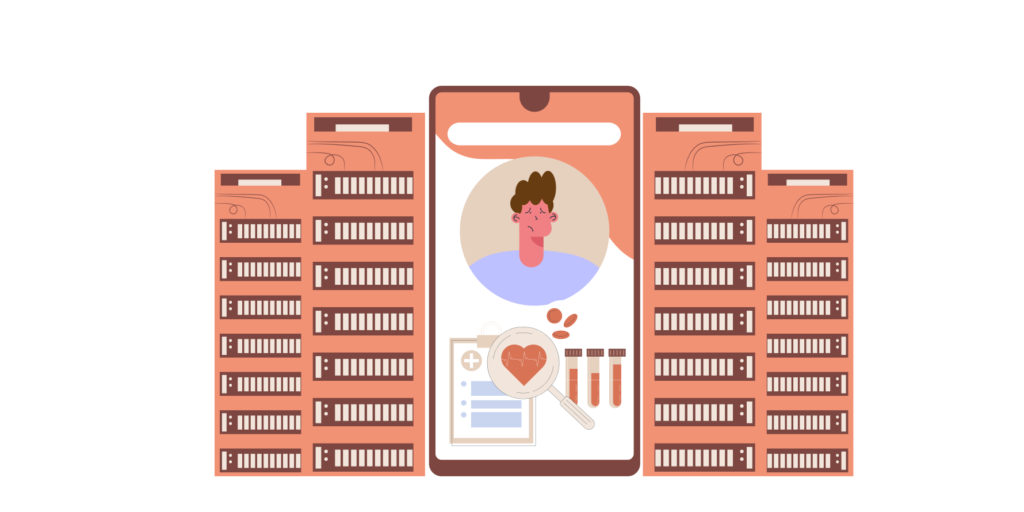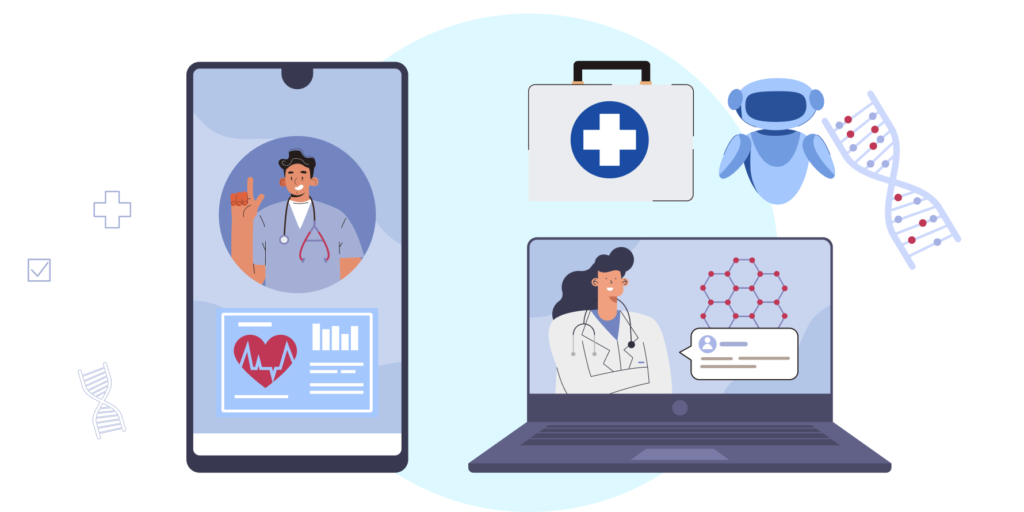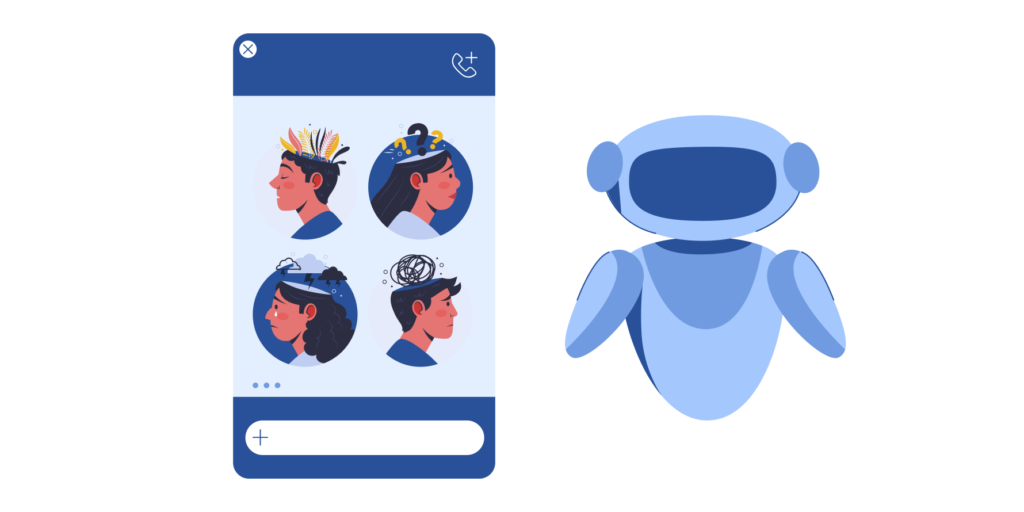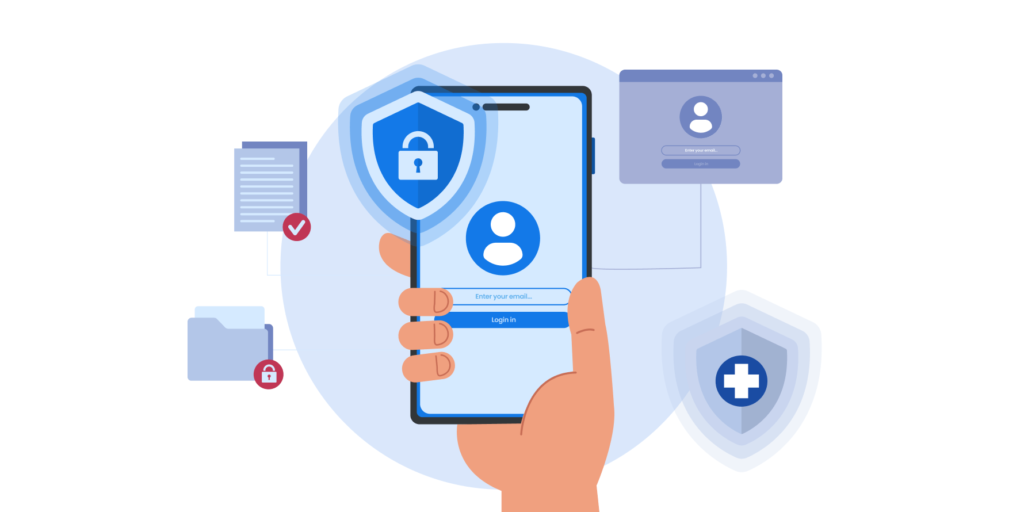Table of Contents
The healthcare industry is constantly embracing technological advancements, as every new innovation brings significant improvements to patient care and to work processes of medical professionals. And while some innovations may be too complex or expensive to implement, there is one that is highly affordable and efficient, and it’s a healthcare chatbot.
Today, chatbots are capable of much more than simply answering questions, and their role in healthcare organizations is quite impressive. Below, we discuss what exactly chatbots do that makes them such a great aid and what concerns to resolve before implementing one.

An overview of chatbots in healthcare: numbers and facts
To understand the role and significance of chatbots in healthcare, let’s look at some numbers. According to the report by Zipdo, the global healthcare chatbot market is expected to reach approximately $498.5 million by 2026. In addition, 64% of patients agree to use a chatbot for information on their insurance and 60% of medical professionals would like to use chatbots to save their working time.
As you can see, chatbots are on the rise and both patients and doctors recognize their value. Bonus points if chatbots are designed on the base of Artificial Intelligence, as the technology allows bots to hold more complex conversations and provide more personalized services. A great example of such bot is Babylon Health. This bot uses AI to provide personalized consultations by analyzing the patient’s medical history and while it cannot fully replace a medical professional, it can for sure provide valuable advice and guidance.
The benefits of chatbots in healthcare
By now, it’s clear that chatbots are widely used both by patients and doctors. But what are the exact benefits of chatbots in healthcare that make them so valuable? Spoiler: many of them have to do with the current challenges that an average medical establishment experiences.
Constant availability
Healthcare organizations all over the world currently face workforce shortages (with COVID-19 being one of the primary factors for that) and in such conditions, the availability of doctors might be in decline. Thus, a 24/7 available digital solution can be a perfect alternative and this is one of the main benefits of chatbots.
While a chatbot in healthcare can not be considered a 100% trusted and reliable medical consultant, it can at least help patients recognize their symptoms and the urgency of their condition or answer their questions. And the best part is that these actions do not require patients to schedule an appointment or stand in line, waiting for the doctor to respond. As for the doctors, the constant availability of bots means that doctors can better manage their time since the bots will undertake some of their responsibilities and tasks.
Faster processing of queries
A distinctive feature of a chatbot technology in healthcare is its ability to immediately respond to a request, and this is another big benefit. In traditional patient care, a patient might have to wait for quite some time to get an answer to their question. With smart chatbots, not only the patient receives a reply within seconds, but exactly when the information is needed the most. And one more great thing about chatbots is that one bot can process multiple requests simultaneously, while a doctor cannot do so. And thus, a chatbot can handle numerous requests in a much more efficient manner.
Collection of information
One of the rising trends in healthcare is precision medicine, which implies the use of big data to provide better and more personalized care. To obtain big data, healthcare organizations need to use multiple data sources, and healthcare chatbots are actually one of them.

When a patient interacts with a chatbot, the latter can ask whether the patient is willing to provide personal information. The bot can also collect the information automatically – though in this case, you will need to make sure that your data privacy policy is visible and clear for users. In this way, a chatbot serves as a great source of patients data, thus helping healthcare organizations create more accurate and detailed patient histories and select the most suitable treatment plans.
Improved user engagement
There are several reasons why chatbots help healthcare organizations elevate their patient care – let’s look at each in a bit of detail.
First, chatbots provide a high level of personalization due to the analysis of patient’s data. In this way, a bot suggests relevant recommendations and guidance and receive advice, tailored specifically to their needs and/or condition.
Second, bots reply to requests within seconds and are always available. Such fast processing of requests also adds to overall patient satisfaction and saves both doctors’ and patients’ time.
Automation of tasks
Depending on their type (more on that below), chatbots can not only provide information but automate certain tasks, like review of insurance claims, evaluation of test results, or appointments scheduling and notifications. By having a smart bot perform these tedious tasks, medical professionals have more time to focus on more critical issues, which ultimately results in better patient care.
Main types of chatbots in healthcare
A chatbot can serve many more purposes than simply providing information and answering questions. Below, we’ll look at the most widespread chatbot types and their main areas of operation.
Prescriptive
As the name implies, prescriptive chatbots are used to provide a therapeutic solution to a patient by learning about their needs and symptoms through a conversation. Such chatbot for medical diagnosis usually asks questions and encourages patients to share their symptoms in order to understand their current condition and what kind of treatment is recommended. Note though that a prescriptive chatbot cannot replace a doctor, and medical consultation is still needed. However, these bots can at least help patients understand what kind of treatment to request and what might be the issue, which is already a good start.
Conversational
Also known as informative, these bots are here to answer questions, provide requested information, and guide you through services of a healthcare provider. If such a bot is AI-powered, it can also adapt to a conversation, become proactive instead of reactive, and overall understand the sentiment. But even if the conversational bot does not have an innovative technology in its backpack, it can still be a highly valuable tool for quickly offering the needed information to a user.
FAQ
This bot is similar to a conversational one but is much simpler as its main goal is to provide answers to frequently asked questions. The questions can be pre-built in the dialogue window, so the user only has to choose the needed one. Despite its simplicity, the FAQ bot is helpful as it can speed up the process of getting the patient to the right specialist or at least provide them with basic answers.
Feedback collection
These bots are used after the patient received a treatment or a service, and their main goal is to collect user feedback and patient data. As we mentioned earlier, the collection of information is vital for the healthcare sector as it allows more personalized healthcare and, as a result, leads to more satisfied patients. Hence, these bots are really important as they help healthcare organizations evaluate their services, understand their patients better, and overall gain a better understanding of what might be improved and how.
Healthcare chatbots: use cases
After we’ve looked at the main benefits and types of healthcare chatbots, let’s move on to the most common healthcare chatbot use cases. We will also provide real-life examples to support each use case, so you have a better understanding of how exactly the bots deliver expected results.
Appointment scheduling
One of the most common processes that happens in every medical establishment is appointment scheduling. However, this process often presents a set of challenges for patients due to a number of reasons. Among them are outdated applications/systems for appointment scheduling, too long waiting lists, complex navigation, and lack of assistance. So how do chatbots battle the issue?
A chatbot is most often integrated with the CRM of a healthcare organization and thus has access to doctors’ time slots and EHRs (electronic health records). So when a patient initiates a conversation with a bot, it does the following:
- Checks the doctors’ schedule for availability and matches it with the patient’s request/schedule;
- Reschedules cancelled or missed appointments;
- Finds and proposes the most suitable slot for a visit;
- Asks a patient about their symptoms and conditions to propose the most suitable medical professional;
- Integrates with the patient’s calendar to send notifications about the upcoming appointment.
And due to a fact that the bot is basically a robot, all these actions take little time and the appointment can be scheduled within minutes. In this way, a patient can conveniently schedule an appointment at any time and from anywhere (most importantly, from the comfort of their own home) while a doctor will simply receive a notification and an entry in their calendar. Looks like a win-win for both sides.
Example: Zocdoc, a chatbot used for connecting patients with right medical professionals and for appointment booking. A great thing about this bot is that it allows easy profile creation for doctors and helps them increase their online visibility and find patients.
Virtual nurses
It might be challenging for a patient to access medical consultations or services due to a number of reasons, and here is where chatbots step in and serve as virtual nurses. While not being able to fully replace a doctor, these bots, nevertheless, perform routine yet important tasks such as symptoms evaluation to help patients constantly be aware of their state.
The main function of such chatbots is checking the patient’s symptoms. It can be done via different ways, by asking questions or through a questionnaire that a patient fills in themselves. In this way, a patient learns about their condition and its severity and the bot, in return, suggests a treatment plan or even notifies the doctor in case of an emergency.
As well, virtual nurses can send daily reminders about the medicine intake, ask patients about their overall well-being, and add new information to the patient’s card. In this way, a patient does not need to directly contact a doctor for an advice and gains more control over their treatment and well-being.

Example: K Health, an AI-powered virtual assistant that provides personalized treatment recommendations. The bot uses the AI technology and the data received from professional clinicians to provide users with valuable medical advice. There are many areas of expertise to choose from, including primary care (diabetes, migraine), weight management, urgent care (cold, rashes, sinus infections), and mental health. Thus, a patient can select their condition and receive professional advice and guidance in a few taps.
Collecting data
We’ve already talked about the importance of collecting patients’ data, and this is another common use case for healthcare chatbots. A chatbot can collect the following information:
- Feedback on provided services;
- General information about the patient;
- Medical information about the patient;
- Insurance information.
By using this information, a medical organization can analyze the efficiency and quality of their services and identify areas for improvement. As well, doctors can gain a better understanding of patients and create a more personalized treatment plan for them, which will ultimately result in better patient care. And finally, all information will be added to a system and will be stored in an organized and centralized manner, thus helping clinics avoid data silos and facilitate admission and tracking of patients’ conditions.
Example: Landbot, a service that provides feedback templates in a form of smart bots and can be integrated into a messenger of choice. The service has a variety of templates and can store the collected information on the needed service, thus transferring the data to your CRM.
Documents and prescriptions management
Another use case for chatbots in healthcare is performance of various tedious tasks. With the help of a bot, a patient can:
- Navigate the process of requesting an insurance coverage;
- File a claim for the reimbursement;
- Track the status of their claims;
- Request a prescription refill.
As for the insurance coverage and claims management, chatbots provide patients a unique opportunity to handle the whole process in a few minutes, with all the information clearly displayed and without the need to call the healthcare organization to clarify any questions.
The automatic prescription refill is another great option as the patient does not have to go to a doctor in person and fill in lengthy forms. The bot collects all needed information, sends it to a doctor, and notifies the patient once the refill is ready to be collected.
Example: Whizard, a chatbot for pharmacy. The bot connects patients and pharmacies and facilitates all processes, related to ordering medicine and refilling prescriptions.
Mental health
The issue of mental health today is as critical as ever, and the impact of COVID-19 is among the main reasons for the growing number of disorders and anxiety. According to Forbes, the number of people with anxiety disorders grew from 298 million to 374 million, which is really a significant increase. And since not everyone can receive sufficient help for their mental health, chatbots have become a truly invaluable asset.
The main function of mental health chatbots is to provide immediate assistance and guidance in the form of useful tips, guided meditations, and regular well-being checks. In addition, such bots can connect a patient with a medical professional if there is an acute issue. In this way, a patient can rest assured that they will receive guaranteed help and their issue will not be left unattended.

Example: Headspace, a true giant in the field of mental health services, acquired an AI-powered Sayana bot to help users monitor their condition regularly and receive assistance and advice, if needed. In addition to the bot, Headspace provides a variety of services like sleepcasts or meditations, which the user can browse independently and according to the current needs.
Concerns and limitations of chatbots in healthcare industry
Chatbots in healthcare industry are awesome – but as any other great technology, they come with several concerns and limitations. It is important to know about them before implementing the technology, so in the future you will face little to no issues.
Lack of human interaction
Despite all the benefits that chatbots bring, many people (both patients and doctors) still do not 100% trust them. Patients may not feel comfortable explaining their issues to a machine, and doctors would rather trust a person with an intricate medical task than a robot that was trained to a certain extent and cannot act on the spot. So what would be the compromise?
When a patient with a serious condition addresses a medical professional, they often need advice and reassurance, which only a human can give. Thus, a chatbot may work great for assistance with less major issues like flu, while a real person can remain solely responsible for treating patients with long-term, serious conditions. In addition, there should always be an option to connect with a real person via a chatbot, if needed. In this way, a patient is responsible for choosing what works best for them.
Limited information
Most chatbots (we are not talking about AI-based ones) are rather simple and their main goal is to answer common questions. Hence, when a patient starts asking about a rare condition or names symptoms that a bot was not trained to recognize, it leads to frustration on both sides. A bot doesn’t have an answer and a patient is confused and annoyed as they didn’t get help. So in case you have a simple bot and don’t want your patients to complain about its insufficient knowledge, either invest in a smarter bot or simply add an option to connect with a medical professional for more in-depth advice.
Cybersecurity concerns
A chatbot can be defined as specialized software that is integrated with other systems and hence, it operates in a digital environment. This means, chatbots and the data that they process might be exposed to threat agents and might be a target for cyberattacks.
Unfortunately, the healthcare industry experiences a rise of attacks, if compared to past years. For example, there was an increase of 84% in healthcare breaches, comparing the numbers from 2018 to 2021. Also, approximately 89% of healthcare organizations state that they experienced an average of 43 cyberattacks per year, which is almost one attack every week.

Considering these numbers, the cybersecurity issue is acute and goes far beyond securing chatbots. In order for a healthcare provider to properly safeguard its systems, they have to implement security on all levels of an organization. And we don’t need to mention how critical a data breach is, especially in the light of such regulations as HIPAA. Hence, every healthcare services provider needs to think about ways of strengthening their digital environment, including chatbots.
Possible errors and misleading information
Chatbots are programmed by humans and thus, they are prone to errors and can give a wrong or misleading medical advice. Needless to say, even the smallest mistake in diagnosis can result in very serious consequences for a patient, so there is really no room for error.
Unfortunately, even the most advanced technology is not perfect, and we are talking about AI-powered bots here. Thus, you need to be extra cautious when programming a bot and there should be an option of contacting a medical professional in the case of any concern.
Expert Opinion
The healthcare industry has been rapidly adopting technology, and now, chatbots have become an integral part of many medical establishments and healthcare apps. While there are several concerns related to the use of smart bots in healthcare, their advantages still outweigh the potential limitations and challenges. By implementing robust security measures and performing advanced ML model training, you will be able to prevent such issues as cybersecurity threats and accuracy of the bot’s responses.
It is also worth noting that modern healthcare bots are highly advanced and are capable of providing truly extensive services to both patients and doctors. This being said, the implementation of a smart bot is becoming a necessity, as these bots reduce the amount of mundane work while allowing doctors to provide better and more personalized patient care.
Final word
While being seriously impacted by the COVID-19, the healthcare industry is steadily gaining traction in terms of its digital transformation and is adopting more and more innovative technologies on a regular basis. Chatbots, being among the most affordable solutions, have become valuable assets for healthcare organizations worldwide, and their value is recognized by both medical professionals and patients.
The implementation of chatbots in medicine, however, calls for solid experience and knowledge, so it’s essential to address a professional development company for that. Having a highly skilled Machine Learning and Data Science department, we at SoftTeco have rich experience in delivering chatbot solutions for healthcare organizations in full correspondence with needed regulations. If you have any questions or simply want more information on chatbots for healthcare, don’t hesitate to contact us – we’ll gladly get in touch with you!


Comments